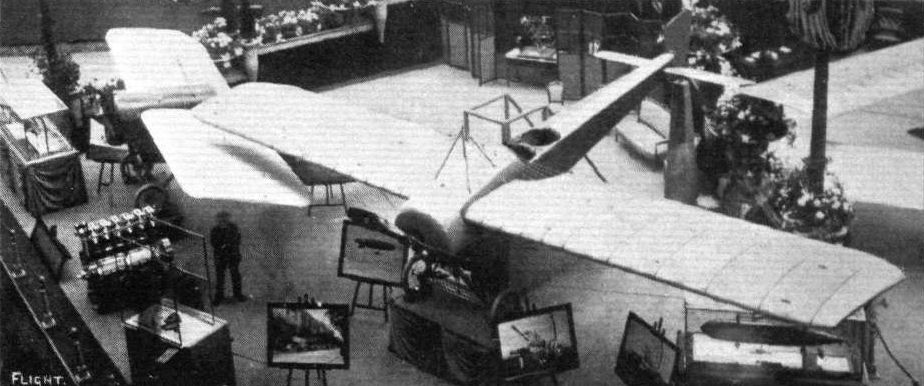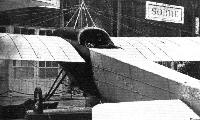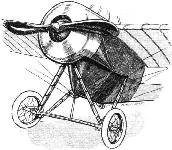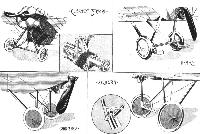L.Opdyke French Aeroplanes Before the Great War (Schiffer)
Deleted by request of (c)Schiffer Publishing
Military monoplane: a 2-seater.
(Span: 12.7 m; length: 9.8 m; wing area: 24 sqm; weight: 380 kg; speed: 90 kmh; 60/70 hp)
Jane's All The World Aircraft 1913
CLEMENT-BAYARD. Usines Clement-Bayard, 33 quai Michelet, Levallois-Perret (Seine).]
1913. 1913.
Military 3-seater Military single seater
biplane. monoplane.
Length............feet(m) 37 (11.20) 24-2/3 (7.50)
Span, upper.......feet(m) 52 (16) 30 (9.20)
Span, lower.......feet(m) 36 (11) ...
Area...........sq.ft(m?.) 533 (50) 172 (16)
Weight,total...lbs.(kgs.) 2425 (1100) 1146 (520)
Weight,useful..lbs.(kgs.) 1014 (460) 441 (200)
Motor................h.p. 100 Gnome 70 Gnome
Speed, max....m.p.h.(km.) 53 (85) 75 (120)
Speed, min... m.p.h.(km.) ... ... Endurance............hrs. ... ...
Notes.--Control: lateral, warping.
Журнал Flight
Flight, December 27, 1913.
THE PARIS AERO SALON - 1913.
CLEMENT BAYARD.
The Clement Bayard firm are showing two machines, of which one is a high-speed single-seater monoplane, while the other is a tandem two-seater. Both machines are very much alike, and are both built of steel practically throughout.
The single-seater is driven by an 80 h.p. Gnome engine, mounted on overhung bearings, and entirely covered in by the engine cowl. The air passes in between the hemispherical shield on the propeller boss and the fixed portion of the cowl, and is allowed to escape through openings in the rear. The fuselage, which is built up of steel tubes, is of pentagonal section in the front portion, while the rear part is triangular in section. On a dash in front of the pilot are mounted the various instruments, and the machine is controlled by means of a single tubular lever, which carries at its upper end a small fixed wheel, which does not rotate but simply forms a convenient handle. A to-and-fro movement of this lever operates the elevator, while the wings are warped by swinging the lever from side to side. The rudder control is effected by means of a foot-bar.
The wings, of which the trailing edge is longer than the leading edge in order to make the warp more efficient, have been cut away near the fuselage to give the pilot a better view of the ground below. The main spars fit into sockets on the side of the fuselage, and the wings are stayed with cables running to a cabane on top and to the low member of the fuselage respectively, while the warp wires pass over pulleys which are also mounted on the keel of the fuselage.
The chassis, which consists of four struts of ash, connected with steel tubes, is illustrated by one of the accompanying sketches, which needs no explanation.
The tail planes of both machines are alike, and are remarkable chiefly on account of the fact that there is no fixed tail plane and that both elevator and rudder are balanced, so that the machine must be very sensitive to the controls. A very simple pivoted ash skid protects the tail planes against contact with the ground.
The two-seater machine is very similar to the single-seater, front which it differs in dimensions only. It is lined with an 80 h.p. Clerget engine mounted on overhung bearings. The pilot's and passenger's seats are arranged in tandem, the passenger occupying the rear seat, from where he has an excellent view in all directions.
The workmanship of these machines, as is to be expected from the Clement Bayard firm, is of the very highest quality, and although the steel construction undoubtedly makes them slightly heavy, the excellent performances put up by Guillaux in his recent flights have amply demonstrated the good qualities and enormous strength under all conditions of these excellent machines.
Flight, March 14, 1914.
WHAT THERE WILL BE TO SEE AT OLYMPIA.
THE EXHIBITS.
Clement Bayard (Delacombe and Marechal). (67.)
A 100 H.P. Gnome-engined Clement Bayard armoured steel scouting monoplane will be exhibited on this stand, similar to that which was at the Paris Salon and described in our issue for December 27th last. The machine is a single-seater and a tractor, the fuselage being covered in on the underside from the engine, which is enclosed by a cowl, to the rear of the pilot, by a casing of nickel steel, for protection against rifle fire. Notwithstanding this, however, the machine is by no means as heavy as one would imagine, and it is possible that this is accounted for, in some measure, by the special system of bracing for the wings which is employed. As has been stated already, it may be said that an all-steel construction is employed, only the ribs for the supporting surfaces being made of wood. An uncovered wing will be on view at Olympia. The steel tubes for the landing chassis are of circular section, but, to reduce air resistance, they have been fitted with wooden streamlines.
In addition to the Clement dirigible engine, which is referred to elsewhere, the Avi-auto carburettor, for which special advantages are claimed, the Aerophote camera, specially designed for aerial work, the La Las Aeroplane telephone, and various forms of the C.A.D. Remote Control apparatus will be exhibited on this stand.
Flight, March 28, 1914.
THE OLYMPIA EXHIBITION.
THE EXHIBITS.
CLEMENT BAYARD (DELACOMBE AND MARECHAL).
THE armoured military single-seater scouting machine exhibited is very similar to the machine shown at the Paris Aero Salon in December last. It is built of steel practically throughout, consistent with the present practice of this famous French firm. The fuselage, which is of pentagonal shape in front running into a triangular section at the rear, is built up of steel tube longerons and struts. The rear portion of it is covered with fabric, whilst the nose and front part up to a point behind the pilot's seat is covered with an armour consisting of 3 mm. thick chrome nickel-steel plate. A cowl of the same material surrounds the engine totally, so that there should be little or no danger of this important member becoming damaged should the machine be subjected to rifle fire. The engine actually fitted in this machine is an 80 h.p. Gnome, but a 100 h.p. Gnome is the engine usually recommended for this type, which is naturally somewhat heavy on account of the armour.
The chassis, as will be seen from one of the accompanying sketches, is of a very simple type, and consists of two pairs of steel tube struts, streamlined with wood and forming a V, as seen from the side. The apexes of the two Vs are connected by two transverse steel tubes, between which move the stub axles resting in slots in the angle between the struts. Springing is provided by rubber cord.
The wings are of unusual construction in that they are built up of wooden ribs over steel spars. An uncovered wing on the stand shows the method of construction. The spars as well as the leading and trailing edges, are of thin channel steel, and very flexible, so that the amount of warp obtainable is enormous. One particular point, however, is open to criticism: there are no compression members between the spars, so that all the compression strains due to the internal cross bracing are taken by the somewhat slender ribs. However, it should be a comparatively simple matter to incorporate compression struts in the construction, and thus obviate this possibly weak point. The wing bracing is somewhat unusual in that the lower lift and warp wires are attached to the lower longeron of the fuselage instead of the chassis as it is usually done, to that should the latter give way in a heavy landing there is still a chance of keeping the wing bracing wires intact. This system also has the advantage that it practically does away with the possibility that collapse of the wings might result from going up in a machine, the chassis of which had been strained without actually breaking in a previous landing, but giving way once the machine was in the air.
The upper bracing cables are supported on a pyramidal cabane and are tightened up by means of an externally threaded tube working in the internally threaded head of the cabane. Control is by means of a single central column terminating in a fixed hand wheel which merely serves as a convenient handle. Swinging the column from side to side operates the warp, whilst a to-and-fro movement actuates the elevator. A pivoted foot-bar operates the rudder.
The tail unit consists of two members only: a balanced elevator of the divided type, having a tubular trailing edge working in a slut in the fuselage, and a balanced rudder.
In addition to the complete machine and the 850 h.p. engine described in last week's issue, there is to be seen on this stand various forms of the C.A.D. Remote Control Gear, the agency for which is held by Messrs. Delacombe and Marechal. This gear works with remarkable ease around right angle bends, and should prove particularly suitable for the various engine controls on an aeroplane.
Flight, November 5, 1915.
CONSTRUCTIONAL DETAILS.-IX.
<...>
The Clement Bayard monoplane, which was also exhibited at the last Olympia Show, had a similar type of Vee chassis, with the exception, however, that ordinary circular steel tubes were used in its construction, the necessary streamline form being obtained by enclosing the tubes in wood casings of the desired section. The two stub axles move between two transverse steel tubes connecting the apexes of the struts, and the manner in which springing is obtained by means of rubber shock absorbers is clearly shown in the detail sketch.
<...>













